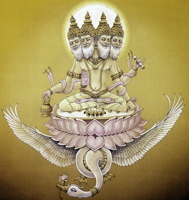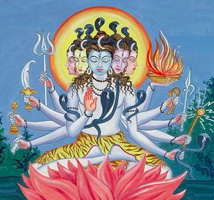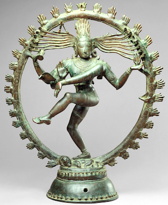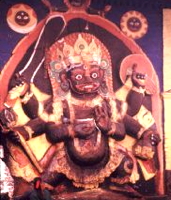Under Construction 
Overview:
Hinduism is the oldest and perhaps the most complex of all the living, historical world religions. It has no one single identifiable founder. The actual names found for the religion in the Hindu scriptures are Vedic Religion, i.e. the Religion of the Vedas (Scriptures) and Sangtana Dharma, i.e. the Universal or Perennial Wisdom and Righteousness, the "Eternal Religion." Hinduism is not merely a religion, however. It encompasses an entire civilization and way of life, whose roots date back prior to 3000 BCE, beyond the peoples of Indus Valley culture. Yet, since the time of the Vedas, there is seen a remarkable continuity, a cultural and philosophical complexity and also a pattern of unity in diversity that evolved in the course of its history, also a demonstrated propensity for deep integration and assimilation of all new and external influences.
Source: Hinduism at United Communities of Spirit (origin.org)
Most forms of Hinduism are henotheistic religions. They recognize a single deity, and view other Gods and Goddesses as manifestations or aspects of that supreme God. Henotheistic and polytheistic religions have traditionally been among the world's most religiously tolerant faiths. As a result, India has traditionally been one of the most religiously tolerant in the world.
Source: HINDUISM | ReligiousTolerance.org
With the rise of Shaivism and Vaishnavism during the first millennium of the Common Era, Hinduism became essentially monotheistic, with a virtual consensus that there is a supreme, absolute, and omnipresent divine entity. Shaivism, Vaishnavism, and Shaktism each regard only one specific Indic deity (Shiva, Vishnu, or Shakti) as the supreme being and principal object of worship, whereas all other divinities are considered merely "sub-gods" or manifestations of it.
Source: Henotheism - Wikipedia
See also Basics of Hinduism - God - HimalayanAcademy.com
Dities:
Larry A. Brown documents the evolution of Hindu Gods at Introduction to Hindu Mythology.
The earliest Vedas dating back to 1200 BC had Indra the storm god, Varuna, god of the ocean, Agni, god of fire, Surya, the sun god, and Yama, god of death.
"By the time that the Mahabharata was written (300 BC - 300 AD), other gods who played only minor roles in the Vedas have become popular.
Three gods in particular came to be known as the Trimurti: Brahma the creator, Vishnu the preserver, and Shiva the destroyer and creator?.
There are similar images of all three and it is hard to tell which is which.
You will see some images of all with multiple arms.
See Brahma-Vishnu-Shiva - A Clearer Understanding of the Hindu Trinity | BLISS OF HINDUISM
Brahma the creator:
 Brahma is that particular great Energy of evolution, of emanation, of manifestation and is the very first light which radiates forth from Brahman each time the universe comes into being, since Brahma is the Universe itself. Brahma is called the Universal Mind or Divine Mind, the Divine Universal Ideation, and all the necessary "material" for manifestation comes forth from and through Brahma at the dawn of Time. Although Brahma is popularly called the Creator, Hinduism does not actually teach creation but teaches emanation and evolution.
Brahma is that particular great Energy of evolution, of emanation, of manifestation and is the very first light which radiates forth from Brahman each time the universe comes into being, since Brahma is the Universe itself. Brahma is called the Universal Mind or Divine Mind, the Divine Universal Ideation, and all the necessary "material" for manifestation comes forth from and through Brahma at the dawn of Time. Although Brahma is popularly called the Creator, Hinduism does not actually teach creation but teaches emanation and evolution.
Source: Brahma-Vishnu-Shiva - A Clearer Understanding of the Hindu Trinity | BLISS OF HINDUISM
You will see images of Brahma with 3, 4 or 5 heads.
At Brahma : Hindu Gods trinity they say,
Brahma has 4 heads but used to have 5.
|
Shiva (Mahesh) the destroyer:
Lord Shiva, has many forms. See Western Hindu.org
 A common image of shiva is this.
A common image of shiva is this.
In his left hand a 'damaru' (small leather drum) represents the Sabda Brahman. It represents OM from which all languages are formed. It is He who formed the Sanskrit language out of the Damaru sound.
Around his neck is a coiled serpent representing Kundalini or the spiritual energy within life.
On his forehead a third eye (Trilochana). Shiva is often depicted with a third eye, with which he burned Desire (Kāma) to ashes, called "Tryambakam" which occurs in many scriptural sources. In classical Sanskrit, the word ambaka denotes "an eye", and in the Mahabharata,
In his right hand a Trident (Trishula) Shiva's particular weapon. His Trisul represents the three Gunas - Sattva, Rajas and Tamas..
See The Shivapuram: Lord Shiva
Shiva at shivalaya.vnc.in says,
"Mahadeva (The Great God) Shiva is the supreme Creator of all."
Of all the aspects of Lord Shiva, one as destructor is perhaps most popular and confusing. To maintain the equilibrium, destruction is as important an aspect as creation and sustenance. Lord Shiva, incarnated as Rudra, to complement Brahma (The Creator) and Vishnu (The Protector), to assume the role of Destructor.
    Mahadeva Panchanana Nataraja Bhairava - fierce form
Great God Five Faces or heads Lord of the dance The annihilator of evil
Mahadeva Panchanana Nataraja Bhairava - fierce form
Great God Five Faces or heads Lord of the dance The annihilator of evil
Shiva is sometimes depicted with 4 arms like Vishnu.
See Panchanana Shiva: Five Aspects of Lord Shiva
Links:
HINDUISM: The world's third largest religion | ReligiousTolerance.org
Introduction to Hindu Mythology
Hinduism at United Communities of Spirit (origin.org)
Vishnu - Wikipedia
Basics of Hinduism - God - HimalayanAcademy.com
Shiva, Shakti, Nataraja
The Five Faces of Shiva | Hindu Human Rights Online News Magazine
Hindu God Shiva : Shiva (Shiv) - the destroyer | SanatanSociety.org
The Origins of Shiva Nataraja | India: Shiva Nataraja (Lord of the Dance) | Freer and Sackler Galleries
Return to Religion.
|
 Religion
Religion

 Religion
Religion


 Vishnu is typically shown with four arms.
The four arms indicate his all-powerful and all-pervasive nature. His physical existence is represented by the two arms in the front, while the two arms at the back represent his presence in the spiritual world (Wikipedia).
Vishnu is typically shown with four arms.
The four arms indicate his all-powerful and all-pervasive nature. His physical existence is represented by the two arms in the front, while the two arms at the back represent his presence in the spiritual world (Wikipedia).